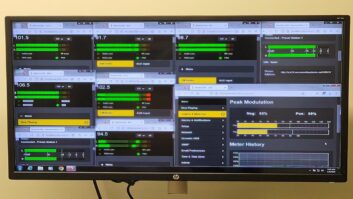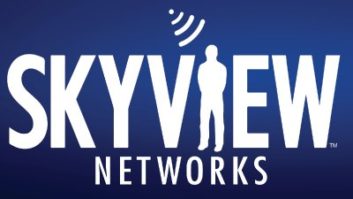One of the workhorses of any broadcast facility is the link between the studio and another location, such as the transmitter. For those where the studio and transmitter address are one and the same, this link can be as simple as a few wires or a couple of coax runs, but in cases where the facilities are separate, a different approach is typically required. With their quasi-ubiquitous nature and robust reliability, the use of public networks has become more much more attractive in recent years.
Although essentially plug-and-play, such networks can be problematic for one simple fact: You are not the master of your destiny. Murphy’s Law would then say that the public network would be unavailable when you need it most. This of course could be due to some sort of disaster situation, or maybe even a Washington-controlled kill-switch. The solution is therefore to construct and maintain your own network.

Perhaps the most common type of delivery is the studio-transmitter link or the intercity relay (ICR) utilizing the 950 MHz band. Authorizations in this band are generally filed as broadcast auxiliaries under Part 74 of the commission’s rules. However, applications in that band, as well as in other bands, can be filed under Part 101 of the rules. In this case, the link facility is authorized under the Private Operational Fixed Point-to-Point Microwave Service, or “OFS” for short. The OFS bands cover a significant amount of real estate from just under one gig, all the way up to 95 GHz.
The first step in adding a radio STL is to do a rough estimation of the general technical requirements and frequency availability. If you are considering a multiple-mile hop in the middle of the great plains with a couple of audio channels, the traditional 950 MHz band is probably the way to go. On the other hand, that band may not be available in a spectrally congested region. Similarly, bandwidth requirements in excess of 500 kHz will also preclude its use. In such cases, the higher frequencies under the OFS rules may be the way to go. Remain cognizant, however, that the upper frequency bands have greater free-space attenuation, and may require a truncation of the path length. Additionally, higher frequencies become more susceptible to issues like rain fade and are more likely to be impacted by temperature inversions and paths over water and other anomalous terrain types. The use of diversity, briefly touched on later, can alleviate these problems.
Before delving into the process for engineering a link, we will take a look at some of the functional differences between the venerable 950 MHz band, and the 11 GHz band (as an OFS authorization). As we will see, the free-space loss along a path increases with the transmission frequency. Thus, a greater ERP may be required to maintain communications on higher bands. Additionally, at 11 GHz
and higher frequencies, rain fade rears its ugly head.

The tradeoff, however, is that the microwave bands allow for a much greater throughput of data. On the 950 band, the maximum permissible transmitted bandwidth is 500 kHz. Even with a robust digital architecture, this bandwidth operationally limits things to say four audio channels and a couple of data channels. If analog architecture is utilized, you are typically looking at the audio for one station. By contrast, the 11 GHz band permits bandwidth of up to 80 MHz. One manufacturer has a system that will provide 350 Mbps data transfer rates utilizing a 56 MHz bandwidth. At that kind of data rates, you can have audio, telemetry, and even a pretty good internet connection.
After establishing a concept based on your data needs, the next course of action is to look at the path between transmit and receive ends of the link. The terrain along the proposed path and the distance between the ends of the link are the important pieces of information here. In the past, the way to create a path profile was to draw the path on USGS topographic maps, and then pick the elevation values off the maps at short and regular intervals. These values were then transferred to 4/3 Earth Radius graph paper and the dots connected. With digitized terrain databases of substantial accuracy now available, software methods of creating terrain profiles have supplanted this methodology. Still, however, ground truth is important to weed out the potential anomalous obstruction. Satellite image applications are invaluable here.
Although the line-of-sight path may be free of obstructions, losses can still come into play if there are obstructions in the Fresnel Zone. Generally sixty percent of the Fresnel zone must be keep clear of obstructions for maximum link performance. The Fresnel zone is an oval-shaped region, with its long axis along the link path, and the radius on the shorter axis a function of frequency and path distance as defined by the following:

Note that since the frequency term is in the denominator of the radical, a higher frequency will necessarily imply a narrower Fresnel zone. The converse is true, and for a five-mile path at 945 MHz, the Fresnel zone at its widest point will be 83 feet in radius. Therefore, in practice it would be preferable to avoid obstructions within about 50 feet of the line-of-sight path.
If the path looks to be viable, then the total loss along the path can be determined. The start of this calculation is to determine the free-space loss. For path lengths in kilometers and frequencies in GHz, this loss is as follows:

This value is then adjusted by the gains and losses on both sides of the system relative to an isotropic source. Since the desired quantity is the total path loss, components in the system such as amplifiers or antennas should have their numerical values subtracted, while components with a loss such as filters and transmission lines should have their numerical values added. Antenna gains are sometimes specified relative to a half-wave dipole. These values should be increased by 2.15 dB to arrive at the equivalent isotropic value.
The total path loss is then subtracted from the transmitter power to arrive at the received carrier level, which will be a negative number. If transmitter power is provided in terms of watts, then it must be converted to dBm or decibels above one milliwatt by the following:

The fade margin is then the difference between the received carrier level and the receiver sensitivity. A negative number implies a non-functioning path, since the sensitivity of the receiver is greater than the signal level. A positive number indicates a functioning path, but is it reliable?
As it turns out, we can actually estimate the reliability based on the fade margin. In addition to the path length (D), fade margin (F), and frequency in GHz, two additional quantities of the terrain factor (a) and climate factor (b) are defined. The suggested terrain factor values range from 0.25 for mountainous or rough areas to 4 for very smooth areas, including paths over water. Recommended climate factor values are 0.5 for coastal areas, 0.25 for temperate areas, and 0.125 for mountainous or dry areas. The outage probability becomes:

This number returns a reliability percentage by the following:

From the reliability percentage, the annual outage time may be determined. Keep in mind, however, that the estimated outage time does not all occur in one shot. Rather it is the estimate cumulative time for a given calendar year. If the reliability is left as a percentage, it is illustrative to take it out to several places past the decimal. Reliabilities of at least 99.999 percent relate to the Ma Bell standard of “five nines.”
To put these numbers in perspective, at 950 MHz, a reliability of five nines for a ten-mile Midwestern path equates to a fade margin of around 18 dB, and an outage time of about 5 minutes per year. The same path and fade margin at 7 GHz drops the reliability to 99.993 percent, and increases the outage time to around 37 minutes per year. To get five nines back on the 7 GHz path, the fade margin would have to be increased to around 27 dB.

The final step before construction and operation of the path is the coordination (officially known as Prior Coordination Notice, or PCN) and the subsequent application process. Since no approved list of coordinators is maintained by the commission, the coordination process can be performed by anyone. Part 101.103 of the commission’s rules spells out the process, but in general a notification by the proponent and response by potentially affected entities else is required. The notification provides the technical parameters to potentially affected entities for their review.
The response can be either active or passive. In the active case, a potentially affected entity specifically communicates in writing with the proponent to either approve or object to the proposed facility. In the passive case, the proponent waits at least 30 days and assumes no objection exists if no response is received. Expedited coordination may be requested, however, it should be noted that the rules imply that a response is required in that case, whereas a 30-day period requires no response for valid coordination.
If objections are raised, the proponent will need to attempt changes to the system to alleviate the concerns. Any changes to the system that cumulatively exceed the major change criteria will then require their own separate notice. Such notices remain valid for six months from their initial date. If an application is not filed in that time, the proponent must resend notices to potentially affected entities. Once coordination is completed, the application can be filed with the commission, the facility constructed and operation commenced.
Occasionally the techniques of diversity are utilized to alleviate issues resulting from interference and fading. A system employing spatial diversity utilizes multiple transmit and/or receive antennas, which create slightly different paths. Anomalous effects along one path typically will not affect a similar path simultaneously, thereby reducing the potential outage time. Since additional equipment is required, this scheme tends to be more expensive.
In the end, a licensed link avoids the pitfalls of unlicensed links and can prevent transmission issues such as light loss on fibers and network performance problems for a myriad of other issues. They allow the station more control over their destiny, but even that comes with a certain price.












